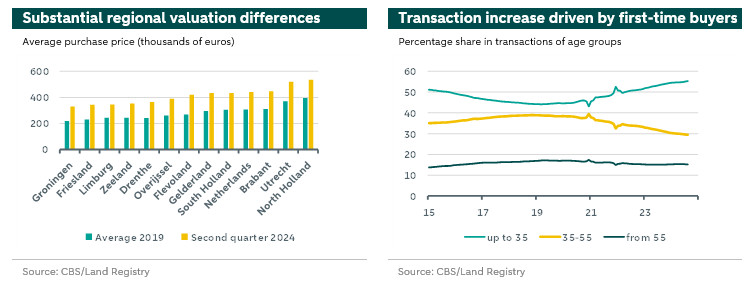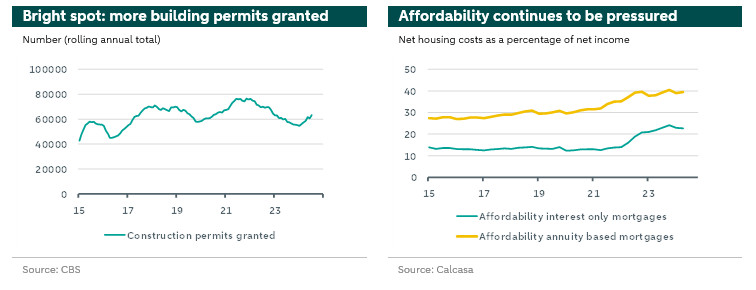Housing market is and remains very tense

We raise our 2024 price estimates from +7.5% to +8.5% and those for 2025 from +5% to +7%. Higher wages, lower interest rates, loosened lending conditions and lack of construction prop up prices. Continued price increases put further pressure on affordability. We also adjust transaction estimates for 2024, from +10% to +12%. The 2025 estimate remains +2.5%.
The trend of price increases continues
In August, the CBS/Kadaster price index for existing homes was 11.2% above the level of a year ago. On average, house prices rose 0.6% on a monthly basis over the past year and a half compared to the previous month. In the short term, there are few reasons to believe that this trend will change. Therefore, we are adjusting our price estimates upward for both this year and next. We are also adjusting the transaction estimate upward in connection with higher realizations this year. The number of transactions will increase by 12% this year, instead of 10%. The increase in 2025 will be smaller, as our forecast for 2024 assumes more than 200,000 transactions, a historically quite elevated level. Therefore, we see less room for growth in 2025. In addition, given the rise in prices, affordability will decline and access to new housing is limited. Our estimate therefore remains at +2.5%.
Higher wages are driving up house prices
The main factors behind price growth on the demand side are higher wages, declining mortgage rates and the widening of mortgage lending standards with respect to preservation and with respect to those borrowing on a single income basis. Statistical analysis shows that rises in collective wage agreements (CWA) have a six-month lag in price growth: a 1% higher CWA translates into 0.73% higher prices six months later. Wage growth is expected to continue, since the labour market is tight. As a result, workers have a relatively strong position in wage negotiations. Although there is a limit to wage increases, as higher wages ultimately lead to fewer jobs and higher unemployment, we expect wage increases to remain relatively high in the coming years. Recently concluded collective bargaining agreements for the coming years also indicate higher wage growth.
The decline in mortgage interest rates also continues
European inflation has fallen to the 2% target level. This means that the ECB can further ease monetary policy by lowering interest rates. According to our forecasts, the ECB will gradually further reduce the deposit rate, which it already adjusted earlier this year from 4% to 3.5%, to 1.5%, the neutral level where monetary policy neither dampens nor stimulates economic activity. As a result, interest rates on longer-dated government bonds will also go down, and in line with this, mortgage rates. The prospect of interest rate declines contributes to confidence in the housing market, although the Dutch housing market is less sensitive to changes in mortgage rates because of the preference among mortgage buyers for long fixed-interest periods, the scope to continue the mortgage when they move house, and the possibility of mortgage interest deductions.
Buyers can borrow more
Thanks to the combination of higher wages and lower mortgage interest rates, buyers can take out larger mortgage amounts when buying a home. The latest figures show that overbidding is again becoming more frequent. In the third quarter, this happened in 69% of home purchases. In the same quarter a year ago this was still 46%. On average, the purchase price was 4.6% above the asking price, compared to 0.3% last year.
Valuations are record high
Meanwhile, according to CBS/Land Registry, the average purchase price is EUR 466,000. That is a new record. However, there are significant differences within the Netherlands. In North Holland and Utrecht, for example, the average purchase price is well above the national average, and in Brabant just barely, while the purchase price in the other provinces is well below the national average. Influenced by Covid and the shift to working from home, price differences narrowed slightly in recent years, but judging from last year's figures, it is uncertain whether this trend will continue. Furthermore, at EUR 509,000, the average purchase price is relatively high in the four major cities. The latter is mainly due to the particularly high price level in Amsterdam and Utrecht, as in The Hague and Rotterdam the average purchase price is just below the national average.
Housing demand is growing, but supply is slow to respond
The number of households is increasing, as the population grows and households become smaller partly due to the influence of an aging population. Against this background, it makes sense that homes are only for sale for a brief period. Homes purchased in the third quarter were on offer for an average of 28 days, only five days more than in the record year 2022. The fact that buyers have little time to decide also has to do with scarce supply. There were 26,000 homes for sale in the second quarter, 3,000 fewer than in the same quarter last year and well below the historical average of 73,000 measured over the period since 1995. Homeowners want to make sure they can move to their next home before putting their home up for sale. With prices continuing to rise, it is also financially attractive to wait.

The number of transactions is on the rise again
In the 12-month period through August 2024, a total of 196,000 existing homes changed hands. In August 2023, there were 185,000. Earlier, during the price dip following the energy crisis, first-time homebuyers postponed moving house, but now that house prices are reaching new record highs, they are starting to move again. However, it is mainly young people and first-time buyers who are keeping the market going. In recent years, they have gained a larger share of home purchases and mortgage applications. Couples with permanent job contracts are finding their way to buying homes fastest after they complete their education.
Landlords are pounding out rental properties
Part of the reason the number of transactions is increasing is because landlords are pulling out and selling rental properties because of new tax and rent laws that make home rentals less attractive. They are mostly pounding out cheaper rental properties. These are mostly apartments. Partly because of this, the share of apartments in housing transactions has increased.
More new construction homes are being bought again
In addition, transactions are attracting existing homes, as transactions of new homes are on the rise again. For a long time, home buyers thought new construction homes were too expensive compared to existing homes. However, the relative price difference has narrowed as existing homes are rising faster in price than new construction homes. Therefore, new construction is getting more attention once again. With more families moving on to new construction, existing homes are becoming vacant, so the number of existing home transactions may increase again.
But there is not much stretch in new construction
There are currently around 90,000 homes under construction that will be completed within one to two years. This means that the goal of adding 100,000 homes a year is likely to remain out of sight in the coming years. So, there is a limit to the flow to new construction. In recent years, many new construction projects have been put on hold because the quorum of buyers was not met, so construction could not begin. In addition, high interest rates, labour shortages and the increased prices of building materials and land played tricks. Therefore, the number of housing realizations will be low in the coming years.
Environmental requirements stand between building permit and completion
Even in the longer term, the government's goal of adding 100,000 new homes annually is ambitious. The number of building permits issued is indeed on the rise, as the interest-sensitive construction sector benefits from the ECB's broader monetary policy. But a building permit is not a new home. From the moment a permit is issued, local residents can file objections, so building plans can still fall through. With all the environmental, nitrogen and noise issues, this remains a real risk with many construction projects, even in the further future. For example, starting in 2027, the Netherlands must meet European standards for the Water Framework Directive for clean surface and soil water. If the Netherlands fails to improve water quality, many construction projects will be compromised, just as with nitrogen.

Government plans to solve housing shortage remain absent
How the government plans to boost housing construction is unclear. Like Rutte IV, it is betting on topping up, splitting and transformation. New are the “street addition” plans. These can help accelerate new construction, but, according to calculations, deliver fewer homes than the cabinet hopes for. Moreover, they mainly provide housing in places where the demand for housing is not as strong. Opinions are also divided about the effect of the construction summit with all the major market parties. The government wants to make binding agreements on housing construction at the construction summit. However, it remains to be seen whether market parties will be tempted to make such binding agreements. They will probably only move if there is money on the table, or if they receive certain concessions. Both conditions are lacking for the time being.
The investment climate needs to be improved
Government policy on rent and tax rules is too fickle for long-term investment decisions. Illustrations of this are the proposals about a plan income tax and a land value tax from the coalition agreement, which were nowhere to be found on Budget Day; the decision to reduce the transfer tax for investors only for rental housing, while different rates for rental housing and commercial real estate increase the complexity of construction projects in which both occur; and the lobbying in Brussels to allow corporations to build housing in the middle rental segment, which commercial market parties consider to be market spoilage.
More, well-targeted money is needed for new construction
Much of the EUR 5 billion the government wants to invest in the housing market will come in the form of a “realization incentive. With this, the government wants to reward municipalities that deliver homes in the affordable segment with a premium. But new construction projects take 10 to 12 years on average. So, the municipalities that benefit from the measure are those that are already well underway with their construction projects, not those that are not yet as far along due to lack of expertise. And if lack of expertise is the problem -which is regularly the case- then just money does not necessarily offer the best solution. Finally, the instrument is aimed unilaterally at municipalities, not at other stakeholders important to construction such as developers. If the government insists on the realization incentive in its current form, the risk increases that the construction target will be too high, and the housing shortage will continue. This will support price levels, but at the same time puts a brake on the number of transactions and mobility in the housing market, and in this sense is socially suboptimal.
